Human Flower Project
Sunday, July 22, 2007
Get Around: Garden Panoramas
This garden project by an international band of geo-photographers will knock your socks off and turn your head all the way around.
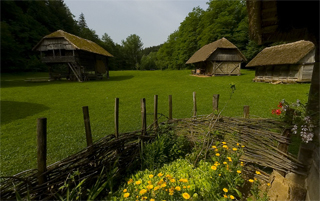
19th Century Garden, Dolenjska, Slovenia
Boštjan Burger
Via: World Wide Panorama
A garden is a 360-degree experience, hard to capture in a still photograph. Close-ups are too short and buggy, wide angles too distant and angelic. And we miss what’s going on above, below, behind the camera.
Rubbernecks and inquiring eyes will be twistfully delighted by Gardens, a collection of interactive panoramas all taken between June 20-25, 2006. Here from Damascus, Syria, Gloucester, Massachusetts, to Himi City, Japan, are scores of gardens—garden visits, really—since, as we move the virtual “eye” across the screen, we are turning around in each environment. You can look down a path in Bodoe, Norway or over a field of pink wildflowers to the Spanish Coast at Coruna, or behind you at a group of hikers in flowerless Queens Garden, Utah.
Photographer and geographer G. Donald Bain at the University of California Berkeley founded the World Wide Panorama project with Landis Bennett. Here on the web, 360-degree photographers from around the world come together four times a year (at the equinoxes and solstices) to document a different theme. In advance of last year’s summer solstice, Don sent out a probing invitation to Gardens. He’s graciously permitted us to excerpt his letter:
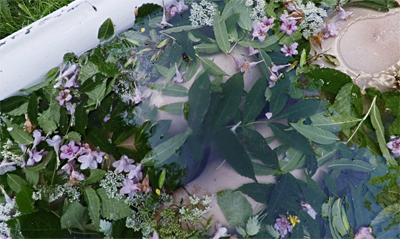
A Garden of Delight, Kammeny Privoz, Czech Republic
Jeffrey Martin, Prague
Via: World Wide Panorama
“Nobody need travel very far to find an interesting subject, or interpret the theme as a metaphor. Just look around, think about what makes gardens in your particular place special and distinctive, then find a good example with photographic possibilities.
“Gardens range from prim little front yards, just lawn and flowerbeds, to elaborate landscapes with plants originating from all over the world, or for that matter fruits and vegetables. Some gardens are small and private, others open to the public and world famous.
“One way of looking at gardens is that they embody our ideals for a vegetated space – filtered by cultural context and physical environment. What makes a garden in Arizona different from one in Connecticut, Hawaii, Italy, Mexico, Alaska, Japan, or Brazil? Each will have distinctive aspects that set it apart from the others….
“Given our ability to alter the environment, even more important than physical factors are our expectations and desires. What do we want from a garden – organic vegetables, brilliant flowers, species native to the region, unusual plants from all over, shade from the sun, shelter from the wind, impressive vistas or intimate spaces? How do we want to manage it – manicured, casual, or wild?
“Each culture evolves its own aesthetic of landscaping. Some are widely understood and emulated – everyone recognizes a classic Japanese garden, for example. But most gardens are subtle variations on a cultural/environmental theme, modulated by local circumstances and individual preferences, and sometimes by institutional mandates.
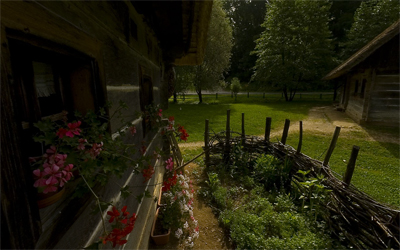
19th Century Garden, Dolenjska, Slovenia
Boštjan Burger
Via: World Wide Panorama
“Every major city has one or more famous gardens, often city parks. London has the Chelsea Physic Garden, established in 1673 to collect and study medicinal plants. San Francisco has the Japanese Tea Garden, a by-product of the 1915 Panama-Pacific Exposition. Kyoto is famous for its temples, including the unique raked gravel Zen gardens. The Missouri Botanical Garden in Saint Louis is a world leader in botanical research as well as a public park. Banyan Park in Lahaina on the Hawaiian island of Maui is covered by a single huge banyan tree.
“Vegetable and fruit gardens reflect culture and environment. In what environments would you expect the following to be grown: olives, apples, papayas, avocadoes? Tomatoes, rhubarb, vegetable marrow, okra, tomatilloes?
“Botanical gardens serve two purposes, research and public education. Some display the vegetation of the world, others focus on the local area. They are usually laid out geographically and all the plants should be labeled. Some contain unusual or unique plants, such as the Victoria lily at Kew Gardens near London, or Captain Bligh’s breadfruit on the West Indian island of Saint Vincent….
“So, take a good look around you, try to interpret the physical and cultural reasons for what you see planted, where and why. Choose a garden, large or small, private or public, flowers or vegetables or lawns. Find a way to bring out its special beauty and interest in your panoramic photography. Learn all about it and write a good caption. Easy!
.(JavaScript must be enabled to view this email address)
Don Bain
Geographer at Berkeley”
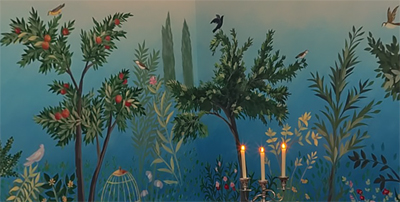
Livia’s Garden, near Front Royal, Virginia, USA
Rose Hughes Steuart’s reproduction of a Roman fresco
at Poplar Forest, a recreation of Thomas Jefferson’s home
Skip Steuart
Via: World Wide Panorama
Scan through thumbnails of all the panoramas or look for gardens by region and nation. This is surely the most amazing human flower project we’ve encountered in months. We especially enjoy how some photographers have dwelled on the human—for example, Rodolpho Pajuaba in his Garden of Ronaldos from Brazil—while others focused on flora or fauna, (feline, in this case). Many of the gardens are grand and famous, others humble.
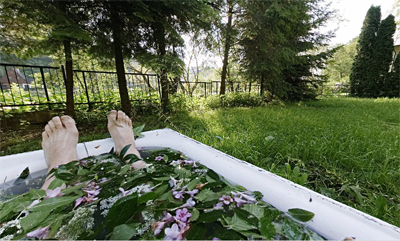
A Garden of Delight, Kammeny Privoz, Czech Republic
Jeffrey Martin, Prague
Via: World Wide Panorama
We hope that readers will get around this thrilling site and let us know your favorites. And we thank Don Bain and these three marvelous photographers for permitting us to share their work here. One final note and question, while looking at these panoramas, we have had the distinct sense of visiting each garden WITH someone. Is it this 360-degree format that turns photography—normally a private and contemplative experience—into something that feels sociable?
Friday, July 20, 2007
Flying Afresh on Rose Wingshttp://www.kitchencapers.net
Here’s something you’ve never done with a chicken, something floral, we mean.

Rose Chicken Wings
Photos (and cooking): Gina Choong
Late July in Texas, we come down with a case of barbecue-itis. Delicious as ribs and chicken are cooked over the outdoor grill (and lucky as we are to be eating anything), we just can’t face another plate of hickory-smoked critter.
Gina Choong to the rescue. Based in Singapore, Gina for three years operated a marvelous multi-ethnic food site called Kitchen Capers, a labor of love dedicated to the memory of a young aspiring chef. Somehow she found time to send us a cure for barbecue-itis, a recipe for Rose Wings.
…two recipes, actually: one for the “Rose Vinegar” marinade, a beautiful floral switch from tomato-based barbecue sauce, the other for the roasted chicken wings. Thank you, Gina, and good luck in your new endeavor!
By Gina Choong
Rose vinegar is fragrant by fresh roses. It can be use for cooking or for making salad dressing. You can use it to marinate meats for roasting.
Rose Vinegar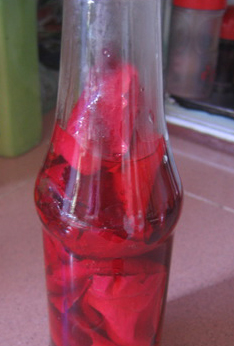
Ingredients
5 Rose Buds (no stalk, no leaves)
make sure to use buds free of herbicides and pesticides!
300ml (1 1/4 c.) Distilled White Vinegar
Method
1. Pour vinegar into a sauce pot and heat over the stove for 5 mins (low heat).
2. Turn off the heat and leave it to cool.
3. Remove petals from the buds.
4. Snip off the white ends of each petal. Discard the white ends, as they are bitter.
5. Push the petals into a cleaned glass bottle.
6. Pour cooled vinegar into the bottle and seal with a cork.
7. Leave it to stand for 3 weeks in a warm and bright place.
8. Use the vinegar according to each recipe.
The vinegar will turn maroon red.
Rose Chicken Wings
Ingredients
10 Chicken Wings
20g Salted butter (melted)
Marinate
100ml Rose Red Vinegar (1/3 c.)
2 tbsp Sesame oil
1 tsp sugar
Method
1. Marinate wings with sauce for 1 hour.
2. Preheated oven 200C for 15 mins.
3. Brush wings with melted butter and roast for 10 to 15 mins.
4. Serve immediately.
Wednesday, July 18, 2007
A Boy Named Hyacinthe
Known best for his portraits of the French royals, Hyacinthe Rigaud had a handle on flowers, too.

Portrait of Jean Le Juge and His Family (detail)
by Hyacinthe Rigaud
National Gallery of Canada, Ottawa
Photo: Lee Sandstead
Rose, Violet, Daisy, Iris—flower names are usually bestowed on girls. Perhaps that custom gave Hyacinthe Rigaud, born male on July 18, 1759, a lot to live down. At age 23, he won the Prix de Rome—entitling him to a year’s study in Italy— but said “no thanks,” choosing to set up his own studio in Paris instead. Seems to have been a good idea, for soon Hyacinthe was accepting commissions from none other than the Sun King, Louis XIV. His portrait of Le Roi Soleil in Alice Cooper wig and white tights is one of the most memorable of all royal portraits. For the throngs of us who’ll never get within hailing distance of a king, Hyacinthe Rigaud’s painting style is positively tactile. You can actually touch His Highness’s curls and calves (if you want to).
In the portrait of Jean le Juge and Family, Rigaud and his assistants paint a whole baroque hand jive. Dad clutches a velvet cape while pointing to his darling daughter, Mother strokes a glossy dachshund and with her other hand, pulls a shawl of modesty over the girl’s shoulder, while sissy holds a parrot on one finger and with the other hand encircles a basket of flowers.
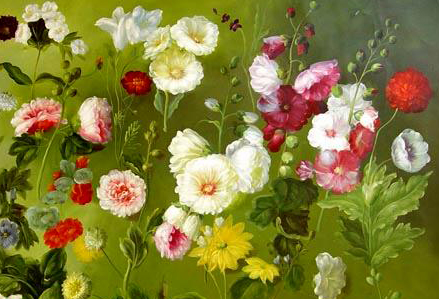
Studies of Flowers
by Hyacinthe Rigaud, c. 1695
Image: ArtNet
Hyacinthe Rigaud is renowned for these well upholstered pictures of the French nobility, but we discover that he was a fine flower painter, too. (Carnations aren’t good patrons, though.) His study of lilies, poppies, mallow and roses, all suspended against a background of gold look as fresh as this week’s flower scans (check out Craig Cramer’s latest).
As in Johnny Cash’s song “Boy Named Sue,” Hyacinthe Rigaud’s father—also a painter—may have wanted to give his boy something to prove. Monsieur Rigaud Senior, here you go.
Monday, July 16, 2007
‘In Lieu of’ for Lady Bird? Not Hardly!
Flowers poured in for the U.S. former first lady, tributes from the mighty and the more-than-meek. Do tell!

At the LBJ Library July 14, friends of Lady Bird Johnson
admired the many floral tributes—and their senders
All Photos: Anonymous
Reading through many obituaries of Lady Bird Johnson, we didn’t once catch sight of the phrase “in lieu of flowers….” Generous as she was to many organizations, notably the Wildflower Center that bears her name, Mrs. Johnson and her family didn’t see fit to discourage blooms as she was mourned and buried this weekend. What a relief and joy!
We weren’t among the guests invited to her private obsequies, but a friend of ours was. At a reception held on the 10th floor of the Lyndon Baines Johnson Memorial Library on Saturday, our friend took a look at the cards tucked in several of the arrangements (and pictures of some other folks doing the same thing). Our friend expressed a smidgen of embarrassment at having peeked at the names, but we assured him/her that such curiosity is only proper. So is spreading the word.
People who send ostentatious (or why don’t we call them “gorgeous”) floral arrangements to a funeral are doing a wonderful thing, and they’re rightfully inviting and deserving credit. In our view, it’s no different than someone with a powerful singing voice really opening up for a hymn. Isn’t there some good advice about not putting your light under a bushel? Likewise, we think, don’t put a sock in your mouth when it’s time to sing or refrain from sending flowers with your name on them to ANY occasion.
So, here are just a few of the many flower arrangements sent to honor Lady Bird Johnson (and to distinguish the givers a bit, too). Many thanks to our delightful and distinguished and discreet camera-toting friend.
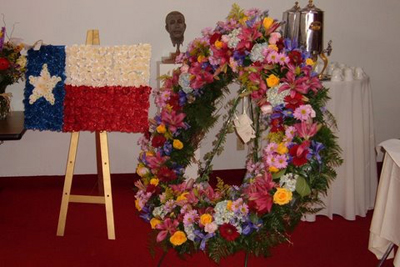
A floral Texas flag from ?? and wreath from pianist Van Cliburn
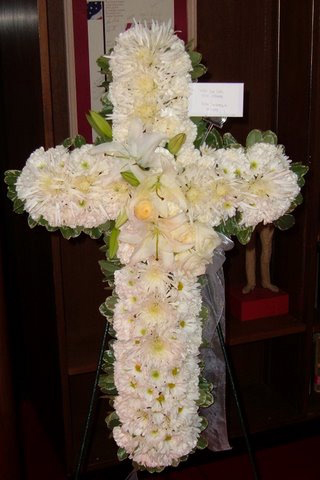
From the Rev. Billy Graham
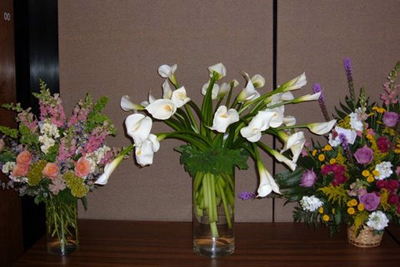
From (l-r) Betty Ford, the Reza Pahlavi family (Shah of Iran), and ??




